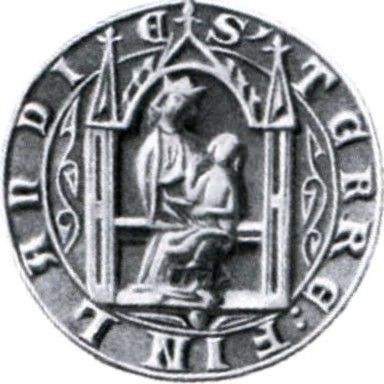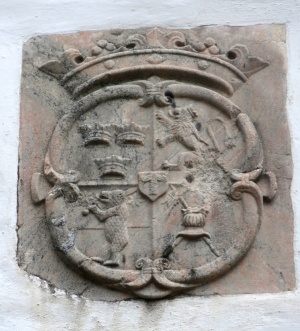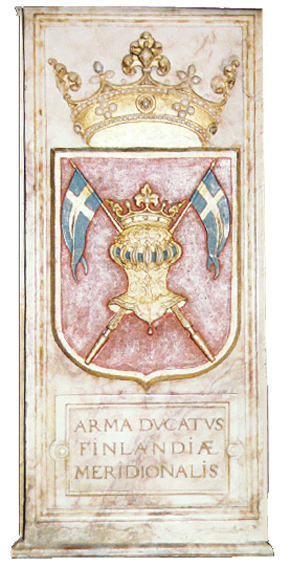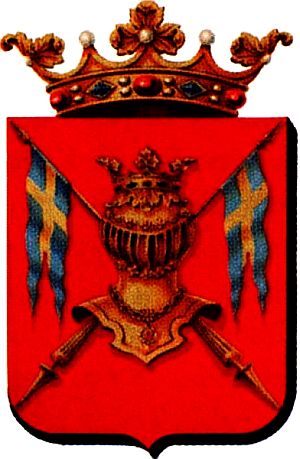Varsinais-Suomi
Finland heraldry portal
This page is part of the Finland heraldry portal |
Heraldry of the World |
|
Civic heraldry:
|
Other heraldry: |
VARSINAIS-SUOMI / EGENTLIGA FINLAND
Historical province until 1634 then part of Turku and Pori province until 1996. Between 1997-2009 part of Länsi-Suomen lääni (province of Western Finland). Re-established as a region in 2009 covering roughly the same area as the historical province.
Official blazon
- (fi) Punaisessa kentässä ristikkäin kaksi kultaista peistä; kumpaankin peitseen on kiinnitetty kaksikielekkeinen sininen lippu, jossa reunoihin ulottuva kultainen risti; peitsien pääliikkeenä kruunullinen kultainen turnajaiskypärä. Kruunu: herttuakunnan kruunu.
- (sv) I rött fält en krönt bygelhjälm överlagd två korslagda glavenstakar, allt av guld; vardera glavenstaken är försedd med en tvåtungad, blå flagga med kors av guld. Skölden krönes med hertigdömets krona.
Origin/meaning
The current arms were officially granted on January 24, 1963. They use the arms of the historical province, virtually unchanged, with a ducal coronet.
The arms show a helmet, taken as a symbol of the Swedish Kings and two Swedish flags. This was the region first colonised by the Swedish Kings, who later conquered the rest of Finland from here.
The oldest known emblem of Finland Proper is the seal of province used in early 14th century, depicting Virgin Mary with child Jesus on her lap.
| The seal from 1326 |
The arms first appear in 1557 when Gustav I of Sweden gave the Duchy of Finland to his son, John III. Arms designed then for the Duchy were quartered, with two quarters with a helmet in front of two flag poles (for Southern Finland, the region of Varsinais-Suomi) and two quarters with a bear holding a sword (for Northern Finland, the region of Satakunta). This was the first known instance where the blue flags with a golden cross were depicted as a symbol of Swedish reign; only later were they used in Sweden as the Swedish flag.
John III altered the granted arms, adding to them the three crowns of Sweden and the arms of House of Bjelbo (both found in the coat of arms of Sweden) with inescutcheon of the House of Vasa.
| The arms of Duchy of Finland used by John III chiselled over the main doorway of the castle of Turku. Photograph by Heikki Halkosaari, 2018 |
When Gustav I died, the arms of Varsinais-Suomi were depicted on his memorial in the Cathedral of Uppsala (1583). At times the depiction of the arms varied (likely due to copying errors). Wrong colours were used, or the flag poles were drawn without flags. The arms were for centuries the traditional arms of the region of Varsinais-Suomi, and in the 19th century they gained the official status as arms of the Province of Varsinais-Suomi.
| Arms of Finland Proper on memorial of Gustav Vasa |
The arms from book by Margareta Grip, 1570, depicting the flag poles without flags and the flag positioned behind the shield |
| The arms in 1887 |
Contact and Support
Partners:
Your logo here ?
Contact us
© since 1995, Heraldry of the World, Ralf Hartemink 
Index of the site
Literature : Iltanen, Jussi: Suomen kuntavaakunat. Helsinki: Karttakeskus, 2013
Ranckén A. W.: Suomen vaakunat ja kaupunginsinetit. WSOY, 1949
Järvi, Petter & Segersven, Anders. Heraldiikka ja historia. Suomen Partioheraldikot ry, 2000
Image of arms on memorial of Gustav Vasa from here.
Thanks to Heikki Halkosaari for provinding the information.
















